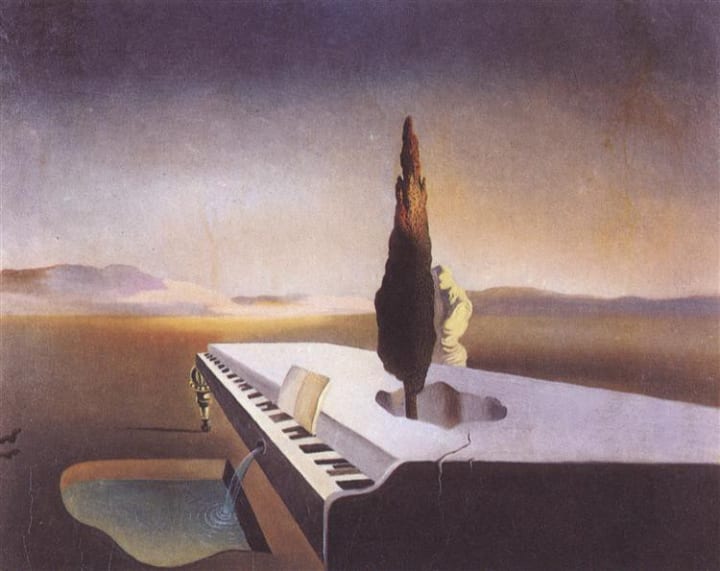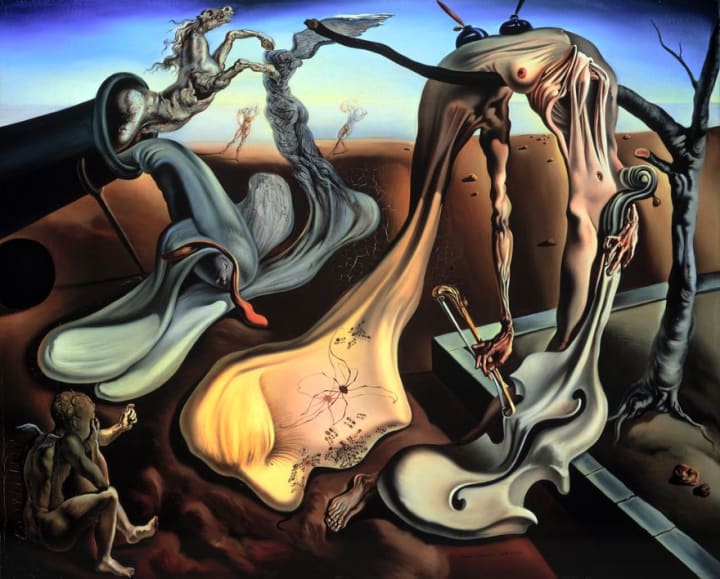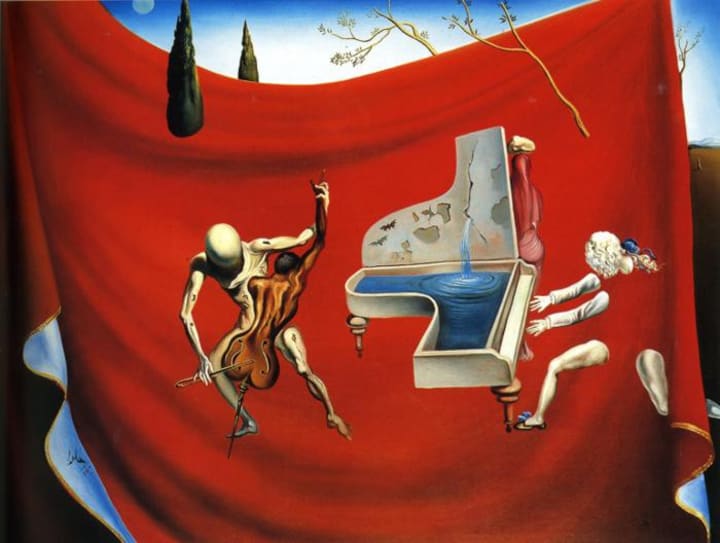Dali's Bizarre Interpretation of Musical Instruments
Did Dali despise music?

Do you know the commonality between Salvador Dali and Sigmund Freud? Well yes, as we all know both of them were geniuses in their respective fields.
But they also shared common anxiety and fear towards 'Music'. You read it right. Both of them literally despised music.
For thousands of years, music has been recommended as a healing tool by shamans to professional psychologists. But Freud, a psychoanalyst, and Dali, an acclaimed painter might have consciously and deliberately decided to stay away from the emotions that music triggers.
As Jung rightly pointed out, that which we try to exclude from our conscious personality inevitably becomes part of the "shadow."
In this article, I'd delve into the weird interpretations of music in Dali's paintings and the possible reasons that might explain his premonition towards it.
Dali's interpretation of music
A nude woman pinching a violin as her skin. A cypress tree emerging from a coffin-shaped grand piano. And an exaggerated elastic female body holding a malleable cello and bow.
This might sound like an uncanny dream-like setting when elements of the conscious and unconscious mind fuse together. Well, what else could we expect when we are in "Dali's surrealist world."
In his book Secret Life of Salvador Dali, he wrote
Against simplicity - for complexity
Against politics - for metaphysics
Against mechanism - for dream
Against music - for architecture
The bizarre representation of musical instruments began with Necrophiliac Fountain Flowing from a Grand Piano in 1933. The coffin-shaped grand piano gushing a stream of water in a piano-shaped pool. The cypress tree coming out of the piano signifies death and the flow of water might portray life leaving a dead soul.

Masochistic Instrument in 1934 shows a nude woman shedding a part of her skin in the form of a violin. The violin is the protagonist and the woman is an antagonist in the painting. Symbolically, it identifies Dali's strong resistance towards music. The bow hitting the cypress tree adds his imagination of equating music with mortality and despair.
Skull with its Lyric Appendage Leaning on a Bedside Table which should have the Exact Temperature of a Cardinal's Nest in 1934 represented a malleable piano with one leg touching the ground and another two in the air. This depicts the inanimate piano sodomizing a skull.

Daddy Longlegs of the Evening-Hope! in 1940 shows a woman whose head is metamorphosed into an elastic female. Her breasts are mimicked by two inkwells (suggesting the signing of treaties and his father as a notary). And ants eat away the woman's mouth as in countless other paintings revealing the destruction of Europe by the fascist regime. The viscous cello and bow suggest the helplessness of Europe's highest authorities against the Nazi rule.
The painting's title refers to an old French peasant legend: a spider seen in the evening is a symbol of good luck.

The Red Orchestra in 1957 replicates the same elements. A damaged piano, cypress trees, and a figure holding the arm of another figure with his body shaped like a violin.

Why was Dali against music?
In none of these paintings did Dali portray the musical instruments in their natural form. They are always distorted; represented in a way to express strong emotions of despair or melancholy.
All these depictions of musical instruments are rooted in Dali's formative musical experience. He spent most of his childhood in Cadaqués. Dali's family had a close relationship with the Pichot family. (Ramon Pichot was Dali's mentor). In fact, the Pichot's often used Dali's family piano.
Plausibly, a grand piano was used by Dali's father to display a book on sexually transmitted diseases and its imagery might have ingrained in his psyche.
For a very long time, Dali experienced the misery of believing that he was impotent - as mentioned in his book The Unspeakable Confessions of Salvador Dali. And his repressed sexuality might have been expressed in obsessive thoughts and fears, including that of music.
At the end of his artistic career, he suffered from depression and Parkinson's disease. Dali might not have comprehended the magic of music but, then, great genius always has its price!
References-
About the Creator
Kamna Kirti
Art enthusiast. I engage with art at a deep level. I also share insights about entrepreneurship, founders & nascent technologies.
https://linktr.ee/kamnakirti






Comments
There are no comments for this story
Be the first to respond and start the conversation.